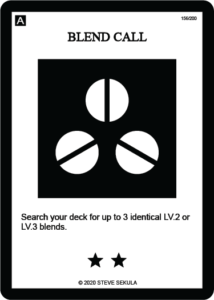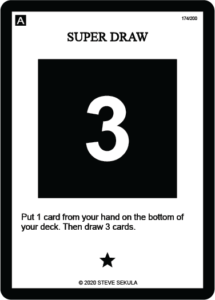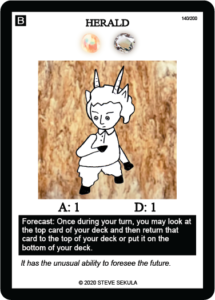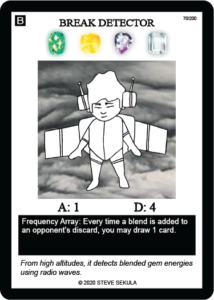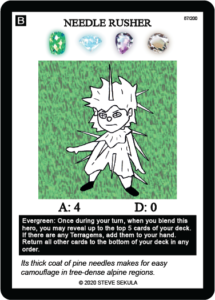TL;DR: Consistency is about a deck’s reliability to achieve its goals and find the resources needed to do so. Keep in mind that having the ability to achieve its goals and being able to reliably do so are two different things. Cards that have effects that increase consistency are called “consistency cards.” By outlining what consistency cards are available in Gem Blenders, I will reveal why certain blend lines are more easily viable and why others have a harder time fulfilling their full potential. A lot of it comes down to what resources they have available, and how many they need, to ensure that their blends can get down onto the table.
In my last blog post I went over some of the lessons I had made during my first couple of months playing Gem Blenders. And as I have continued to play, my knowledge about the game and its intricacies have continued to grow. So, I feel that it is a natural continuation to go on to write about what has been the biggest focus for me lately when building decks. To no surprise for the frequent players in the Discord group, I am of course up in the air about the topic of consistency. This blog post will thus solely focus on what consistency is, and why I am so concerned with it.
What is “consistency”?
Though we all to some degree are acquainted with what consistency means, I wish to go a bit deeper and find a consistent way of defining it. So, let’s look around on the internet and see how other players define it.
“Consistency is all about ensuring your deck is efficient enough to make sure your goal or strategy occurs as fast and as often as possible.”1
Miner 751 of PokéAus
Alright, consistency is about being able to actually get the goal of the deck down on the table — makes sense, it is about reliability. Though, what does Miner 751 mean with “fast?” Typically, I think of the pace at which a deck can run to be in terms of “tempo.” Tempo would be cards like Claire and Usher as they get extra gems down on the field before the deck would otherwise be able to. A deck that can get 3 gems on turn 1 is a fast deck, but not necessarily a consistent deck. This usage of “fast” does not make sense to me. But if we instead consider “fast” to refer to obtaining the resources at an increased pace to ensure that they are available the turn they are needed so the deck is able to cut down on slow turns where nothing happens, it makes more sense.
“Consistency is the most important part of deck building. It is very important to make sure the deck runs how it is supposed to.”2
Michael Pramawat of ChannelFireball
A slight nitpick with the statement made by Michael is that it would also lump in effects I generally would classify as protection or resistance effects — effects that can recover gems if hit by a Drain, Cancels to counter an opponent’s Cancels, and so on. Though they help to make the deck run how it is supposed to, they are in a deck to counter external threats and not to increase the likelihood of obtaining needed resources. Instead, I suspect that Michael says “runs how it is supposed to” in relation to “bricking.” Bricking happens when a player keeps drawing into cards that do not progress the given board-state. This can be by drawing doubles or cards that are not needed at the time, such as 5 Pyrogems. A card that has a high potential to cause scenarios like these is typically referred to as a “brick.” A focus on consistency helps remove bricks or at least limits them or finds ways to resolve them, making it so “the deck runs how it is supposed to.”
Stalkingvengeance, a card game blogger, reflects on consistency in the realm of reliably getting into combos and obtaining resources, so one is able to finish the game.3
I think Stalkingvengeance is spot on here; it does not accidentally lump in a broad array of cards and is only in reference to obtaining resources and getting to a point where a win condition can reliably be achieved.
Based on these statements and the discussion of them, I believe consistency can be defined as follows:
Consistency is about making a deck likely to achieve its goal(s) and obtain needed resources.
A deck that is very unlikely to find the resources needed, or often draws into doubles or bricks in general, is an inconsistent deck. A deck that can reliably or often find the resources needed to obtain its wanted board state, and has few to no bricks, is a highly consistent deck.
A goal is typically a win condition. Hitting for 15 damage a turn, 25 damage a turn, depleting the opponent’s deck, and so on, would count as win conditions. Resources are, in this case, cards that the deck either needs in order to successfully set up said win condition or to reliably be able to find cards that can answer specific threats. Consistency is not about a deck’s ability to win or even be resilient to aggression or have the potential to adapt. Consistency is simply about being able to find the resources that can help in those situations. As well, if a deck has multiple goals, goals in stages, or recovery, consistency can be related to each of these aspects. A deck might have good consistency for a part of the game or for certain aspects, while not for the others. A consistent deck is not necessarily a good deck, but a deck that can’t reliably set up is seldom any good either.
How does a deck increase its consistency?
Any given deck can push its consistency by increasing or decreasing the number of copies of any given card. By including cards with similar or synergetic effects it can also be thought of as adding extra copies, but I don’t think this is easy to do in Gem Blenders at this stage, even though some blend lines have access to good secondary attackers. Another way to increase consistency is to include cards that help to reach the cards that a given deck wants to see. One can include search options, such as Bishop or Gem Search; draw effects, such as Eleanor and Carter; or cycle options, such as Jewl, Draw, or Yule Puffer.
These cards are also referred to as “consistency cards.” Any card which has an effect that increases consistency (such as search, draw, and cycle effects) is a consistency card. This is not just me pulling a term out of my hat. It is established terminology inside of the Pokémon TCG4, and seems to be at least somewhat utilized in Yu-Gi-Oh!5, as well as in Magic the Gathering6.
Different types of consistency serve different purposes. Searching increases reliability and allows one to decrease the number of copies of a card because they can reliably be searched out. This also decreases the risk of bricking. These types of cards are typically referred to as “Tutors” in MTG. Drawing allows one to simply draw past the bricks, increasing the likelihood of seeing cards one wants to see, and is typically associated with card advantage. Cycling and scryíng simply allow one to refresh one’s hand, or next draw, increasing the likelihood of not drawing or being stuck with unwanted cards; they smooth out one’s draws and can resolve bricks.
I believe the biggest distinction between types of consistencies appears when it comes to deck searching (reliable consistency), such as Kula, Bishop, and Bluster Mage versus every other type of consistency (general consistency): drawing, cycling, scrying, etc. This is because, especially in Gem Blenders, search effects can form the foundation for search engines that can ensure that the deck can come from its starting point to its end goal more or less every game. By linking up different heroes, such as Hickory into Bishop into Pine Cone, Glow Herald, or any other LV.3 if that is the aim of the deck, search effects can be lined up so no matter the draws, all blends and even gems can be found, just through the starting heroes. Though draw, cycle, and scry effects will increase the likelihood of seeing the cards needed, it does not ensure them in the same way as searching does.
Consistency in Gem Blenders
Though there is a wealth of consistency options which are not reliant on a given gem makeup, unfortunately (or fortunately) not all blend lines in Gem Blenders are made equal as to what consistency resources they are given. This creates huge discrepancies in the viability of certain blends through no fault of their own — they just don’t have the right tools for the job. But let’s break down what consistency options are available in Gem Blenders, so they can be properly analyzed.
- Heroes: Reliable Consistency
• Gloria (LV1), Jubilee* (LV.1), Min-Seo (LV. 1), Fatima (LV. 2), Hickory (LV. 2), Kula (LV. 2), Fiona and Isabel (LV. 2), Dimitri (LV. 3), Selma (LV. 3), Yumi (LV. 3), Zachary (LV. 3), Chao (LV. 4), Judith (LV. 4), Monica (LV. 4), and Erica (LV. 5).
*Jubilee is often played as an enabler — that is, she can provide the deck with gems it otherwise would not be able to include. Still, she can reliably provide that gem and ensure the deck has the resources it needs, when it needs them, in order to achieve its goals.
- Heroes: General Consistency
• Lola (LV. 2), Isidora (LV. 3), Tara (LV. 3), Jericho* (LV. 3), Carter (LV. 4), Abbey (LV. 4), Denver (LV. 4), Eleanor (LV. 5), Jewl (LV. 5), and Matthew (LV. 5).
*Jericho can find the given blend that the player wants, but the player cannot rely on getting to use his effect as it is outside of their control if it will succeed. Therefore, I lump him in with General Consistency.
- Actions: Reliable Consistency
• Blend Search, Gem Search, Swap, Exchange, Super Blend Search (1-Star), and Blend Call (2-Star).
- Actions: General Consistency
• Collect, Draw, Super Draw (1-Star), Super Collect (2-Star), Replicate (2-Star), and Amass (3-Star).
Overall, there are a lot of good consistency options that are not tied to any given gem combination, but apart from getting LV. 2 options from Min-Seo and Hickory, or LV. 3 options from Kula combined with Blend Search, there are not a lot of reliable consistency engines here. Let’s get to the blends.
- Blends: Reliable Consistency
•Bishop, Chiller*, Cone, Mage, Bluster Mage, Milk Herald, Pristine Mage, Glow Herald, Pine Cone, Tinder Ram*, and Feather Nester
*Neither Chiller nor Tinder Ram in and of themselves provides consistency, but they can either become consistency effects or enable other consistency effects to be used, which is why I have included them here.
- Blends: General Consistency
•Fowl, Chiller*, Herald, Steam Usher, Tinder Ram*, Break Detector, Needle Rusher, Aurora Beamer, Yule Puffer
*Chiller and Tinder Ram can both become a Reliable Consistency effect or a General Consistency effect, so they are listed twice.
Listing all the different consistency cards that are available in Gem Blenders helps to give an overview of what is possible, and shows which blend lines have access to which options. There are 6 total blends with a Luciogem, 8 blends with a Nocturnagem, 5 blends with an Aerogem, and 7 blends with a Caprogem, for example. Electrogems show up only 4 times, and there are only 2 times Aquagems show up, which is in stark contrast to how many times Cryogems (8) and Pyrogems (9) show up.
This, however, does not reveal how good and flexible each of the given blends is. Blends like Milk Herald, Feather Nester, and Needle Rusher are very particular with the types of cards they can search out, limiting what decks can find use for them. This also goes for Mage and Break Detector, which are very particular about how to trigger their effects. Glow Herald is similar, as it needs a lot of gems out before it can begin to see usage. Blends like Fowl and Steam Usher both require some willingness to get rid of cards, which not all decks benefit from or even tolerate. Though they successfully are able to decrease the risk of bricking, not all decks can utilize them to the fullest. Chiller and Tinder Ram both have great flexibility but come at a high cost which opposing decks can exploit, making them slightly risky. It is clear that not all consistency cards are made equal and often come with some associated risk or situational usage.
This does not make them bad, but just means that some blends are favored compared to others. Though Tinder Ram is slightly risky, it does provide very good search options for both blends and gems through Fatima and Selma, who in the first place establish a direct route to get Tinder Ram. To top it off, it even has access to consistent tempo through Claire, giving a strong footing for all blends in its blend line. If those blends are good, they have a strong search engine to rely on, and will thus be likely to see their full potential flourish.


It’s all about creating lines of consistency with engines that have a very high likelihood of finding all the needed resources. Kula into a Blend Search and a Gem Search is another example of this. Kula can ensure that Mage is always available and will provide a Caprogem to get started, though it costs two gems to find those actions. This can often be sorted out by either using Fatima or simply having a high number of gems in the deck in the first place. Then Kula can find another Blend Search to find Bluster Mage and in this way can find all the wanted blends.
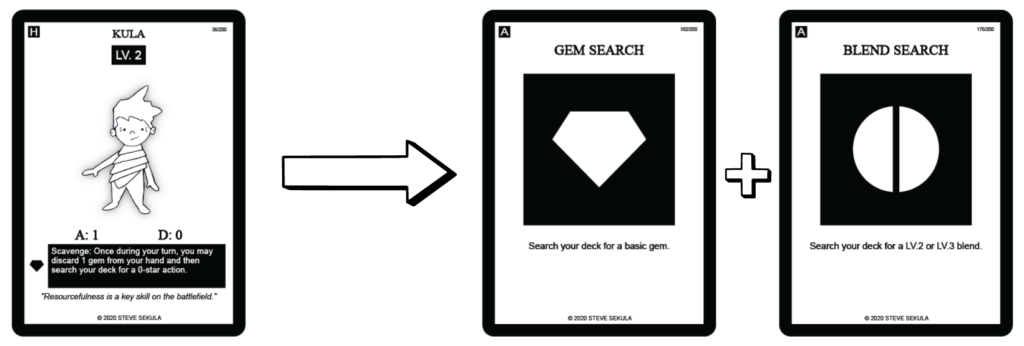
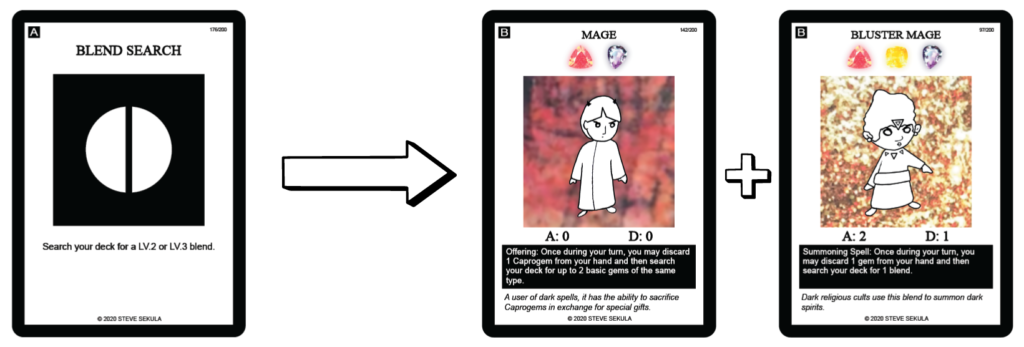
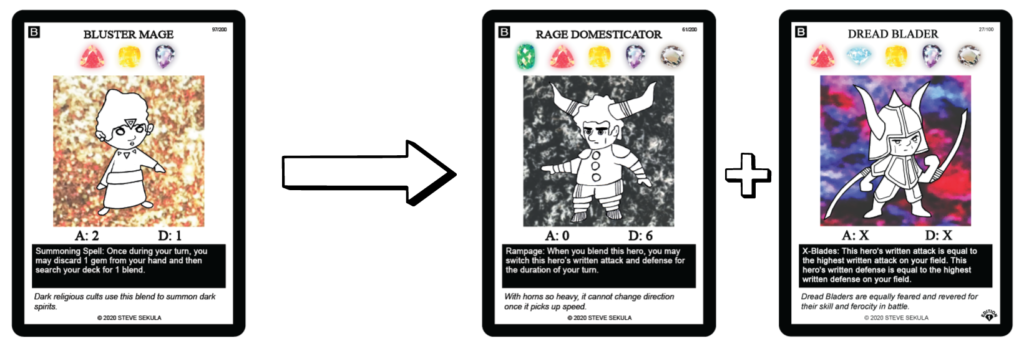
Kula provides a direct path to both the end goal blends as well as to gems needed, though the deck does have to be built around this idea. It removes a lot of luck as the blends will always come out of the deck one way or the other.
The same can be done with Kula or Bishop into cards such as Pine Cone or Glow Herald.
Min-Seo and Hickory can, in similar fashion, weaponize Bishop into an engine which allows for the finding of both good LV. 3s and gems. Bishop can in turn find either Pine Cone or Glow Herald allowing it to find all LV. 4 and LV. 5 blends that the setup wants. Min-Seo and Hickory can also reliably find tempo through Usher. This means that blend lines that have both Cone and Usher, only counting Mantis Slasher so far, will be highly reliable as well as fast, though they might need some help in order to get to the LV. 4s and LV. 5s.
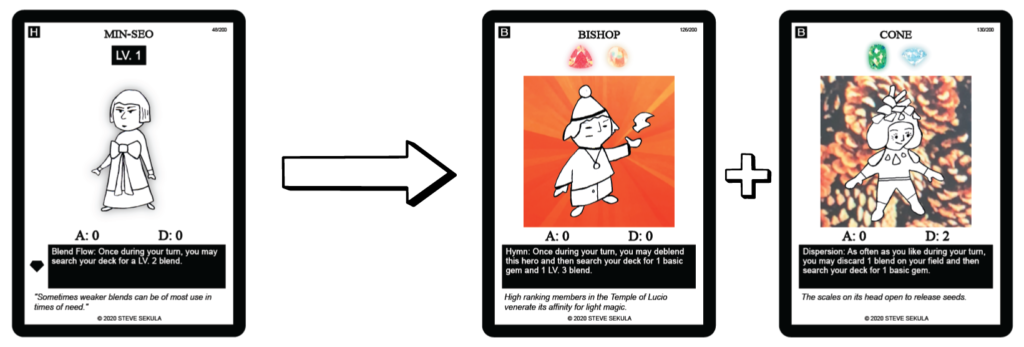

Not all blends have easy access to engines like these that ensure that they will obtain the resources needed. Blends like Mantis Slasher, Skyward Commander, Season Ascender, or Photo Synthesizer have to either include a Caprogem, a Pyrogem, or a Cryogem to give them access to either Glow Herald or Pine Cone. These decks have to go out of their way in order to access reliable search engines, which risk making them less consistent in other departments – in particular, they are less resilient to obstruction as they have to make room for additional cards, as well as lose tempo by putting gems down that they would not otherwise need.
And then there are blends like Storm Weaver that either need to rely on cards like Premium Chiller to access Electrogem-based blends like Bluster Mage or Feather Nester, or simply include a lot of gems that are otherwise not in the gem makeup, hitting them even harder when it comes to resilience and tempo.
For Storm Weaver this is not too bad. It has access to a good secondary fighter in the form of Hail Dominator, and some obstruction in the form of Flurry Shifter, so it has other paths to a victory condition. As well, it does not need additional blends to pull off its effect or goal; it can stand on its own. Still, it feels very slow to play, and not being able to reliably see it when it is needed pulls the deck down. Having a lack of consistency engines built into their blend line hurts those blends that need the support to function. Blends like Season Ascender and Photo Synthesizer are especially hit by this. I even tried to include Bluster Mage to make Photo Synthesizer work but with little success.
Also, just because a blend line has access to a lot of search engines, it does not mean that it is automatically great. If it relies on a lot of high-level blends, it can constrain what heroes it has access to, thus losing out on many of the great low-level heroes like Hickory or Min-Seo. As well, if the power level of the end goal is simply too low, or the tempo of the deck is not there, it won’t help much that it can consistently get out what it needs to. These caveats, to a large extent, all apply to Joy Ringer. Apart from itself it does not have access to a lot of tempo options. And because it needs a consistency option to get the full usage of its effect, it needs additional blends like Yule Puffer as support. That is all on top of the restrictions it puts on the deck itself to have cards that it can use for its effect.
concluding thoughts
Consistency is a key component of all decks. Being able to reliably set up is crucial. Consistency helps to find the needed resources as well as avoid bricking, which can cause a deck to lose tempo. Of the strongest kind of consistency, we have search engines, which can create a reliable path to fulfill the deck’s goals. Decks with search engines can be relied upon to always, or at least most of the time, produce the wanted outcomes, which influence their viability. If a deck does not have this reliability, it will suffer as it will have more games where it won’t succeed in getting out what it needs to and will more easily be beaten by the opponent. Not all blends have easy access to consistency engines and will suffer in other departments when trying to include them, and some blends need more resources than other blends, which can restrict the deck in other ways. Though there are ways to make up for inconsistencies, I believe that many blends and blend lines are being held back simply due to the low consistency that are available in their lines. They simply do not have the tools to get onto the field, even if they have other ways to buy themselves more time.
references
- https://www.pokemonaustralia.com/pokemon-tcg-attaining-the-art-of-consistency/
- https://strategy.channelfireball.com/all-strategy/pkmn/prams-guide-to-optimizing-decklists/
- https://cubiccreativity.wordpress.com/2021/05/15/the-upstart-goblin-conundrum/
- https://strategy.channelfireball.com/all-strategy/pkmn/rate-yourself-as-a-player-knowing-strengths-attacking-weaknesses/
- https://qtoptens.com/top-10-best-draw-cards-in-yugioh/
- https://mtgazone.com/simic-turns-historic-deck-guide/












